
The black rosy finch or black rosy-finch is a species of passerine bird in the family Fringillidae native to alpine areas above treeline, of the western United States. It is the most range-restricted member of its genus, and a popular photography subject for birdwatchers.

Ninia atrata, known commonly as Hallowell's coffee snake, Hallowell's earth snake, the red-nape snake, and the South American coffee snake, is a species of small terrestrial snake in the family Colubridae. The species is native to southern Central America and northern South America.
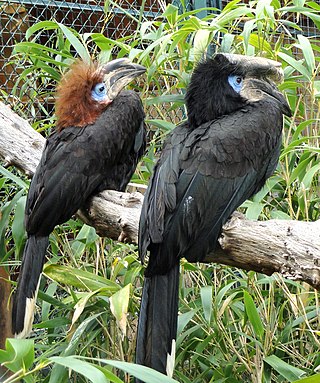
The black-casqued hornbill, or black-casqued wattled hornbill, is a species of hornbill in the family Bucerotidae. It is found fairly commonly across sub-Saharan Africa, being known from Sierra Leone and Liberia in Western Africa, south to Angola and east to the Democratic Republic of the Congo and western Uganda. The population is decreasing.

Megarhyssa, also known as giant ichneumonid wasps, giant ichneumons, or stump stabbers, is a genus of large ichneumon wasps, with some species known for having the longest ovipositors of any insects. They are idiobiont endoparasitoids of the larvae of wood-boring horntail wasps. The ovipositor can be mistaken for a large stinger. This is a genus of holometabolous insects within subfamily Rhyssinae that includes 37 species and belongs to Ichneumonidae, the family of wasps with the highest biodiversity in the world.
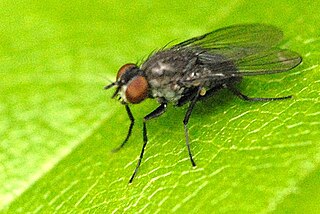
Coenosia is a very large genus of true flies of the family Muscidae. Coenosia are known as tiger flies since they are predators and hunt many kinds of insects and other invertebrates.
Coenosia elegans is a species of fly in the genus Coenosia. It is found in Alaska.
BugGuide is a website and online community of naturalists, both amateur and professional, who share observations of arthropods such as insects, spiders, and other related creatures. The website consists of informational guide pages and many thousands of photographs of arthropods from the United States and Canada which are used for identification and research. The non-commercial site is hosted by the Iowa State University Department of Entomology. BugGuide was conceived by photographer Troy Bartlett in 2003 and since 2006 has been maintained by John VanDyk, an adjunct assistant professor of entomology and a senior systems analyst at Iowa State University. The website has been recognized for helping change the public perception of insects.
Megachile atrata is a species of bee in the family Megachilidae. It was described by Smith in 1853.

Phosphuga is a European genus of carrion beetle, whose sole member is the species Phosphuga atrata. The beetle is up to 15mm long and has an elongated neck that it uses to reach into snail shells, which it sprays with a digestive fluid. The beetle feeds on live snails, insects and earthworms, as well as on carrion. Newly moulted beetles are brownish in color, older ones are black. The larvae are black and flattened and feed on snails as well. They pupate in the ground. Adults are flightless, lacking flight muscles.

Coenosia agromyzina is a species of fly in the family Muscidae.
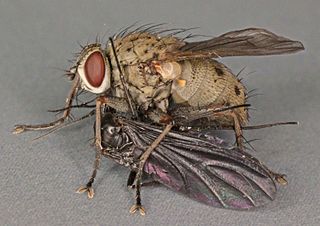
Coenosia tigrina, the hunter fly, killer fly, or common tiger fly, is a species of fly in the family Muscidae. Like other members of the genus, adults are predators that hunt flying insects, while larvae feed on earthworms. It is found in the Palearctic.

Tropiduchidae is a family of planthoppers in the order Hemiptera. There are at least 160 genera and 600 described species in Tropiduchidae.
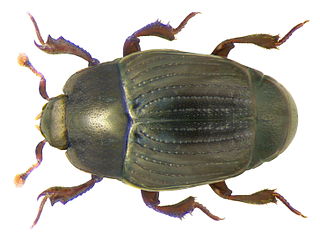
Carcinops is a genus of clown beetles in the family Histeridae. There are at least 50 described species in Carcinops.
Javesella atrata is a species of delphacid planthopper in the family Delphacidae. It is found in North America.

Javesella is a genus of delphacid planthoppers in the family Delphacidae. There are at least 20 described species in Javesella.

Rhyssinae is a subfamily of parasitoid wasps in the family Ichneumonidae. It contains eight genera and 259 described species, but there are likely many undiscovered species.
Coenosia nivea is a species of house flies, etc. in the family Muscidae.
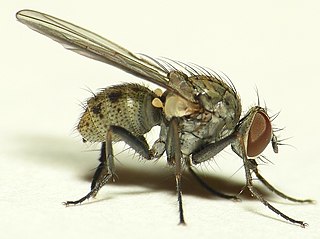
Coenosia humilis, the tiger fly, is a species of house flies, etc. in the family Muscidae. It is found in Europe and Antarctica.
Coenosia lata is a species in the family Muscidae.
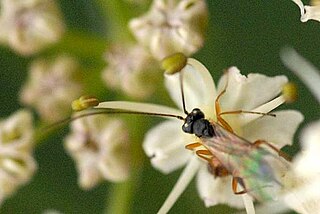
Clistopyga is a genus of ichneumon wasps in the family Ichneumonidae. There are at least 30 described species in Clistopyga.













